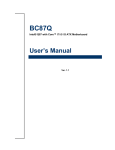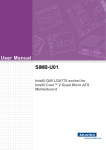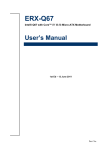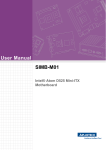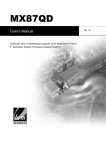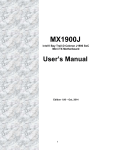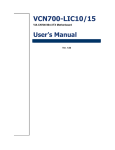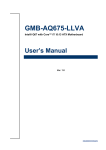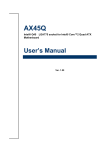Download User's Manual
Transcript
EAX-Q87 Intel® Q87 with Core™ i7/ i5/ i3 ATX Motherboard User’s Manual 1st Ed – 22 October 2013 Part No: E2047AQ8700R EAX-Q87 User’s Manual FCC Statement THIS DEVICE COMPLIES WITH PART 15 FCC RULES. OPERATION IS SUBJECT TO THE FOLLOWING TWO CONDITIONS: (1) THIS DEVICE MAY NOT CAUSE HARMFUL INTERFERENCE. (2) THIS DEVICE MUST ACCEPT ANY INTERFERENCE RECEIVED INCLUDING INTERFERENCE THAT MAY CAUSE UNDESIRED OPERATION. THIS EQUIPMENT HAS BEEN TESTED AND FOUND TO COMPLY WITH THE LIMITS FOR A CLASS "A" DIGITAL DEVICE, PURSUANT TO PART 15 OF THE FCC RULES. THESE LIMITS ARE DESIGNED TO PROVIDE REASONABLE PROTECTION AGAINST HARMFUL INTERFERENCE WHEN THE EQUIPMENT IS OPERATED IN A COMMERCIAL ENVIRONMENT. THIS EQUIPMENT GENERATES, USES, AND CAN RADIATE RADIO FREQUENCY ENERGY AND, IF NOT INSTALLED AND USED IN ACCORDANCE WITH THE INSTRUCTION MANUAL, MAY CAUSE HARMFUL INTERFERENCE TO RADIO COMMUNICATIONS. OPERATION OF THIS EQUIPMENT IN A RESIDENTIAL AREA IS LIKELY TO CAUSE HARMFUL INTERFERENCE IN WHICH CASE THE USER WILL BE REQUIRED TO CORRECT THE INTERFERENCE AT HIS OWN EXPENSE. Ne This guide is designed for experienced users to setup the system within the shortest time. For detailed information, please always refer to the electronic user's manual. Copyright 2013 Avalue Technology Inc., ALL RIGHTS RESERVED. No part of this document may be reproduced, copied, translated, or transmitted in any form or by any means, electronic or mechanical, for any purpose, without the prior written permission of the original manufacturer. Brand and product names are trademarks or registered trademarks of their respective owners. Disclaimer Avalue Technology Inc. reserves the right to make changes, without notice, to any product, including circuits and/or software described or contained in this manual in order to improve design and/or performance. Avalue Technology assumes no responsibility or liability for the use of the described product(s), conveys no license or title under any patent, copyright, or masks work rights to these products, and makes no representations or warranties that these products are free from patent, copyright, or mask work right infringement, unless otherwise specified. Applications that are described in this manual are for illustration purposes only. Avalue Technology Inc. makes no representation or warranty that such application will be suitable for the specified use without further testing or modification. Life Support Policy 2 EAX-Q87 User’s Manual EAX-Q87 User’s Manual Avalue Technology’s PRODUCTS ARE NOT FOR USE AS CRITICAL COMPONENTS IN LIFE SUPPORT DEVICES OR SYSTEMS WITHOUT THE PRIOR WRITTEN APPROVAL OF Avalue Technology Inc. As used herein: 1. Life support devices or systems are devices or systems which, (a) are intended for surgical implant into body, or (b) support or sustain life and whose failure to perform, when properly used in accordance with instructions for use provided in the labeling, can be reasonably expected to result in significant injury to the user. 2. A critical component is any component of a life support device or system whose failure to perform can be reasonably expected to cause the failure of the life support device or system, or to affect its safety or effectiveness. A Message to the Customer Avalue Customer Services Each and every Avalue’s product is built to the most exacting specifications to ensure reliable performance in the harsh and demanding conditions typical of industrial environments. Whether your new Avalue device is destined for the laboratory or the factory floor, you can be assured that your product will provide the reliability and ease of operation for which the name Avalue has come to be known. Your satisfaction is our primary concern. Here is a guide to Avalue’s customer services. To ensure you get the full benefit of our services, please follow the instructions below carefully. Technical Support We want you to get the maximum performance from your products. So if you run into technical difficulties, we are here to help. For the most frequently asked questions, you can easily find answers in your product documentation. These answers are normally a lot more detailed than the ones we can give over the phone. So please consult the user’s manual first. To receive the latest version of the user’s manual; please visit our Web site at: http://www.avalue.com.tw/ EAX-Q87 User’s Manual 3 EAX-Q87 User’s Manual Product Warranty Avalue warrants to you, the original purchaser, that each of its products will be free from defects in materials and workmanship for two years from the date of purchase. This warranty does not apply to any products which have been repaired or altered by persons other than repair personnel authorized by Avalue, or which have been subject to misuse, abuse, accident or improper installation. Avalue assumes no liability under the terms of this warranty as a consequence of such events. Because of Avalue’s high quality-control standards and rigorous testing, most of our customers never need to use our repair service. If any of Avalue’s products is defective, it will be repaired or replaced at no charge during the warranty period. For out-of-warranty repairs, you will be billed according to the cost of replacement materials, service time, and freight. Please consult your dealer for more details. If you think you have a defective product, follow these steps: 1. Collect all the information about the problem encountered. (For example, CPU type and speed, Avalue’s products model name, hardware & BIOS revision number, other hardware and software used, etc.) Note anything abnormal and list any on-screen messages you get when the problem occurs. 2. Call your dealer and describe the problem. Please have your manual, product, and any helpful information available. 3. If your product is diagnosed as defective, obtain an RMA (return material authorization) number from your dealer. This allows us to process your good return more quickly. 4. Carefully pack the defective product, a complete Repair and Replacement Order Card and a photocopy proof of purchase date (such as your sales receipt) in a shippable container. A product returned without proof of the purchase date is not eligible for warranty service. 5. Write the RMA number visibly on the outside of the package and ship it prepaid to your dealer. 4 EAX-Q87 User’s Manual EAX-Q87 User’s Manual Contents 1. Getting Started .............................................................................................................. 7 1.1 Safety Precautions ...................................................................................................... 7 1.2 Packing List ................................................................................................................. 7 1.3 Document Amendment History ................................................................................... 8 1.4 System Specifications ................................................................................................. 9 1.5 Architecture Overview – Block Diagram .................................................................... 11 2. Hardware Installation ................................................................................................. 12 2.1 Product highlights...................................................................................................... 12 2.2 Motherboard Overview .............................................................................................. 15 2.2.1 Placement Direction ................................................................................................. 15 2.2.2 Screw Holes ............................................................................................................. 15 2.2.3 Motherboard Layout ................................................................................................. 16 2.3 Jumper and Connector List ....................................................................................... 17 2.4 Central Processing Unit (CPU).................................................................................. 19 2.4.1 Installing the CPU..................................................................................................... 20 2.4.2 Installing the CPU Heatsink and Fan........................................................................ 22 2.5 System Memory ........................................................................................................ 25 2.5.1 Overview .................................................................................................................. 25 2.5.2 Memory Configurations ............................................................................................ 26 2.5.3 Installing a DIMM...................................................................................................... 26 2.5.4 Removing a DIMM.................................................................................................... 28 2.6 Expansion Card......................................................................................................... 28 2.6.1 Installing an Expansion Card .................................................................................... 29 2.6.2 Configuring an Expansion Card ............................................................................... 29 2.6.3 PCI Express x16 slot ................................................................................................ 29 2.6.4 PCI Express x 4 slot ................................................................................................. 30 2.6.5 PCI slot..................................................................................................................... 30 2.7 Setting Jumpers & Connectors ................................................................................. 31 2.7.1 Clear CMOS Jumper (JCMOS1) ......................................................................... 31 2.7.2 ATX/AT Mode Selection (JPSON1) .................................................................... 31 2.7.3 COM2 Ring-In/ +12V/ +5V Select (JCOMPWR1) ............................................... 32 2.7.4 Set COM2 RS-232/422/485 Mode (JSETCOM1) ................................................ 32 2.7.5 ATX Power Connectors: EATXPWR1 ................................................................. 33 2.7.6 12V ATX Power Connector (ATX12V1) .............................................................. 33 2.7.7 Serial Port 1 Connector (COM1) ......................................................................... 34 2.7.8 Serial Port 2 Connector (COM2) ......................................................................... 34 EAX-Q87 User’s Manual 5 EAX-Q87 User’s Manual 2.7.9 Serial Port 3~6 Connectors (COM3~6) ............................................................... 35 2.7.10 LPT Port Connector (LPT1)............................................................................... 35 2.7.11 2.7.12 2.7.13 2.7.14 2.7.15 2.7.16 2.7.17 Front Panel Connector (F_PANEL1) ................................................................. 36 Fan Connectors (CPU_FAN1, SYS_FAN1, CHA_FAN1) .................................. 36 SATA Ports (SATA1~6)..................................................................................... 37 Front USB Headers (USB56, USB78, USB910, USB1112) .............................. 37 Front Panel Audio Connector (FPAUD1) .......................................................... 38 Amplifier Connector (JAMP1) ............................................................................ 38 Digital I/O Connector (JDIO1) ........................................................................... 39 3. BIOS Setup .................................................................................................................. 40 3.1 Introduction ............................................................................................................... 40 3.2 3.3 3.4 Starting Setup ........................................................................................................... 40 Using Setup ............................................................................................................... 41 BIOS Menu Screen ................................................................................................... 42 3.4.1 Main Setup .......................................................................................................... 43 3.4.2 Advanced BIOS Setup ........................................................................................ 44 3.4.3 Chipset ................................................................................................................ 66 3.4.4 Boot..................................................................................................................... 77 3.4.5 Security ............................................................................................................... 78 3.4.6 Save & Exit.......................................................................................................... 79 6 EAX-Q87 User’s Manual EAX-Q87 User’s Manual 1. Getting Started 1.1 Safety Precautions Warning! Always disconnect the power cord from your chassis whenever you work with the hardware. Do not make connections while the power is on. Sensitive electronic components can be damaged by sudden power surges. Only experienced electronics personnel should open the PC chassis. Caution! Always ground yourself to remove any static charge before touching the CPU card. Modern electronic devices are very sensitive to static electric charges. As a safety precaution, use a grounding wrist strap at all times. Place all electronic components in a static-dissipative surface or static-shielded bag when they are not in the chassis 1.2 Packing List Before you begin installing the single board, make sure that the following materials are included in the package: 1 x EAX-Q87 ATX Main board 1 x DVD-ROM contains OS drivers 2 x COM cable 2 x SATA cable 1 x I/O shield EAX-Q87 User’s Manual 7 EAX-Q87 User’s Manual 1.3 Document Amendment History Revision 1 st Date October 2013 Comment Initial Release This manual describes the Avalue Technology EAX-Q87 Single Board. We have tried to include as much information as possible but have not duplicated information that is provided in the standard IBM Technical References, unless proven to be necessary to aid in the understanding of this board. We strongly recommend that you read this manual carefully before attempting to install the EAX-Q87 series or change the standard configurations. Whilst all the necessary information is available in this manual, it is recommend to contact your supplier for guidance for any queries and concern. Please be aware that it is possible to create configurations within the CMOS RAM that may make booting impossible. If this should happen, clear the CMOS settings, (see the description of the Jumper Settings for details). If you have any suggestions or find any errors concerning this manual and want to inform us, please contact our Customer Service department with the relevant details. 8 EAX-Q87 User’s Manual EAX-Q87 User’s Manual 1.4 System Specifications System CPU Socket LGA1150 supports Core i7/i5/i3 CPU BIOS AMI 64 Mb BIOS System Chipset Intel® Q87 I/O Chipset Nuvoton NCT6776F Memory Watchdog Timer H/W Status Monitor Expansion Slots 4 x 240 Pin DIMM sockets supports DDR3 memories 1066/1600/1333 MHz up to 32GB Reset: 1 sec.~255 min. and 1 sec. or 1 min./step Monitoring temperatures, voltages, and cooling fan status. Auto throttling control when CPU overheats 1 x PCI-E x16 slot, 1x PCIe x4 slot, 1x PCIe x1 slot 4 x PCI Slots (PCI 2.3 compliant) DIO 8 Bit (4 in, 4 out) S3 / S4 Yes Wake up on LAN or Ring Smart Fan Control LAN (PXE) Yes, CPU FAN(by SIO) Display Chipset Intel® Graphics Media Accelerator HD 4000/5000 Series Display Memory DVMT Support up to 1.7GB Memory Max. Resolution 2048 x 1536 bpp(@ 75Hz) Triple Display DVI , VGA, Display Port VGA on board, up to 2048 x 1536 DVI on board, via level shifter, up to 1920 x 1200 Display Port on board, up to 1920 x 1200 Audio Audio Codec Realtek® ALC892, 5.1 +2 with two independent Streaming Audio Interface Line in,Line Out,Mic-in Ethernet LAN1 Intel I217LM Gigabit Ethernet controller (PHY) LAN2 Intel I210-AT Gigabit Ethernet controller Back I/O Port 1 x PS2 KB/MS Back Panel 1 x VGA 1 x DVI-D EAX-Q87 User’s Manual 9 EAX-Q87 User’s Manual 1 x Display port 1 x COM Port (RS-232) 2 x RJ45 port 4 x USB 3.0 1 x 3 Audio Jacks(Line-in/Line-Out/Mic in) Internal I/O Connector 6 x SATAIII connectors (RAID 0, 1, 5, 10 supported) 4 x USB 2.0 connectors support additional 8 USB ports 1 x USB 2.0 connectors (Vertical A type) 5 x COM header (COM2: RS-232/422/485 supported, w/ +5V&+12V supported, selected by jumper; COM3~6, RS-232) 1 x CPU Fan connector 1 x System Fan connector Internal I/O 1 x Chassis Intrusion header 1 x Front Audio connector 1 x Front panel header 1 x Printer port 1 x 8 Bit DIO connector 1 x AT / ATX power jumper 1 x 24-pin ATX Power connector 1 x 4-pin ATX 12V Power connector Mechanical & Environmental Power Type AT/ATX Operating Temperature 0~60°C (32~140°F) Operating Humidity 0%~90% relative humidity, non-condensing Size (L x W) 12'' x 9.6'' (304.8mm x 243.84mm) Weight 1.32lbs (0.6Kg) 10 EAX-Q87 User’s Manual EAX-Q87 User’s Manual 1.5 Architecture Overview – Block Diagram The following block diagram shows the architecture and main components of EAX-Q87. EAX-Q87 User’s Manual 11 EAX-Q87 User’s Manual 2. Hardware Installation 2.1 Product highlights 2.1.1 Product Overview Supports latest Intel LGA 1150 CPU-socket interface processor, the 4nd Generation Intel® Core i3, i5, i7 desktop processors which are built on 22 nm technologies to provide smart performance and responsiveness on executing tasks, It combines the CPU and GPU to offer fantastic HD media and graphics, especially on 3D gaming experience. DMI (Direct Media Interface ) architecture connects between the processor and chipset at 5.0GT/s which twice the speed of previous version. The exceptionally increased interconnect bit rate from 2.5GT/s up to 5.0GT/s would effectively eliminates the bottle neck of the system performance and brings the most terrific computing experience from the present to the future. Doubles the transfer speed of SATA 3G, running at speed up to 6.0Gb/s, and can connect with any other SATA 3.0Gb/s and 1.5Gb/s devices for backward compatibility. Supports RAID 0(Striped disk array), RAID 1(Mirroring disk array), RAID 5(Block Interleaved Distributed Parity), RAID 10 (A Stripe of Mirrors). Provides users the performance and protection. Integrated 5.1-channel HD Audio CODEC delivering advanced multi-channel audio and bringing you the experience of home theater-quality sound. Delivers transfer speed ten times faster than conventional 10/ 100 Ethernet connections, supporting a high transfer rate up to Gigabit/s. Gigabit LAN is the networking standards for the future and is ideal for handing large amount of data such as video, audio, and voice. Choose an environment-friendly, fully RoHS-compliant ECS product as the foundation for keeping harmful substances out of our ecosystem. 2.1.2 Platform Features and Benefits •Integrated Gfx (Intel® HD Graphics 4000/4600) with enhanced operating modes to enable excellent graphics performance in power and cost sensitive embedded applications • DirectX® 11.1 & Open GL 4.0 let you enjoy awesome graphics performance, stunning 3D visual effect and dynamic interactivity • Memory support, integrated low voltage DDR3 memory controller • Operating system support: - Microsoft 12 EAX-Q87 User’s Manual EAX-Q87 User’s Manual -WindRiver -Redhat -Novell -Green Hills -QNX - LinuxWorks 2.1.3 Key Architecture Features • Supports Intel LGA 1150 CPU, the 4nd Generation Intel® Core i3, i5, i7 desktop processors. -22nm monolithic die -Integrated Gfx (Intel® HD Graphics 4000/4600) & memory controller -4 &2 Cores, up to 8MB LLC -HW accelerated video CODECs - Compatible with high speed DDR3-1600 -PCIe* (CPU): Gen 2.0, 5GT/s, up to 20 lanes (4 ctls)** -TDP: 35W-65W (22nm Haswell Platform) • Intel® Turbo Boost Technology -More efficient power sharing between CPU and Graphics • Intel® Hyper-Threading Technology • Intel® Advanced Vector Extensions 2 (Intel® AVX2) • Intel® Transactional Synchronization Extensions (TSX) • Integrated Display Interfaces - Triple Independent Display Support - DVI-D - Analog VGA - Display Port • Intel® HD Graphics 4000/4600 - DirectX® 11.1 - Improved realism for DX 3D applications. Improved rendering. - OpenGL 4.0 - Improved realism for OGL 3D based application - UVD (Unified Video Decoder) 2.01 Hardware decode of most common HD codecs (MPEG-2, H.264/AVC MPEG-4 and VC-1) - Supports ATI Hybrid CrossFireXTM Technology2 • Intel Quick Sync Video - Enables faster and higher quality video editing, recording and sharing • I/O - PCI Express® x 16 Gen 3 8GT/s EAX-Q87 User’s Manual 13 EAX-Q87 User’s Manual - PCI Express® x 4Gen 3 8GT/s - PCI 2.3 interface - Six SATA ports (6 ports of Gen 3.0) support RAID 0,1, 5, 10 - Gigabit Ethernet Media Access Controller (GbE MAC) IPv4 and IPv6 Checksum Offload - High Definition Audio - USB: Gen 2.0, up to 9 Ports / Gen 3.0, up to 4 Ports - SMBus 2.0 - LPC Bus Supports SPI devices - Hardware Monitor Fan control (Voltage, Temp) Watchdog timer • Power Management - Dual Dynamic Power Management Separate power planes for cores and memory controller - Advanced Configuration and Power Interface (ACPI) 5.0 - AMD PowerNow! and AMD Cool’n’Quiet technologies support Before you Proceed Take note of the following precautions before you install motherboard components or change any motherboard settings. Unplug the power cord from the wall socket before touching any component. Use a grounded wrist strap or touch a safely grounded object or a metal object, such as the power supply case, before handling components to avoid damaging them due to static electricity Hold components by the edges to avoid touching the ICs on them. Whenever you uninstall any component, place it on a grounded anti-static pad or in the bag that came with the component. Before you install or remove any component, ensure that the ATX power supply is switched off or the power cord is detached from the power supply. Failure to do so may cause severe damage to the motherboard, peripherals, and/or components. 14 EAX-Q87 User’s Manual EAX-Q87 User’s Manual 2.2 Motherboard Overview Before you install the motherboard, study the configuration of your chassis to ensure that the motherboard fits into it. Refer to the chassis documentation before installing the motherboard. Make sure to unplug the power cord before installing or removing the motherboard. Failure to do so can cause you physical injury and damage motherboard components. 2.2.1 Placement Direction When installing the motherboard, make sure that you place it into the chassis in the correct orientation. The edge with external ports goes to the rear part of the chassis as indicated in the image below. 2.2.2 Screw Holes Place eight (8) screws into the holes indicated by circles to secure the motherboard to the chassis. Do not over tighten the screws! Doing so can damage the motherboard. Place this side towards the rear of the chassis. EAX-Q87 User’s Manual 15 EAX-Q87 User’s Manual 2.2.3 Motherboard Layout 16 EAX-Q87 User’s Manual EAX-Q87 User’s Manual 2.3 Jumper and Connector List You can configure your board to match the needs of your application by setting jumpers. A jumper is the simplest kind of electric switch. It consists of two metal pins and a small metal clip (often protected by a plastic cover) that slides over the pins to connect them. To “close” a jumper you connect the pins with the clip. To “open” a jumper you remove the clip. Sometimes a jumper will have three pins, labeled 1, 2, and 3. In this case, you would connect either two pins. The jumper settings are schematically depicted in this manual as follows: A pair of needle-nose pliers may be helpful when working with jumpers. Connectors on the board are linked to external devices such as hard disk drives, a keyboard, or floppy drives. In addition, the board has a number of jumpers that allow you to configure your system to suit your application. If you have any doubts about the best hardware configuration for your application, contact your local distributor or sales representative before you make any changes. The following tables list the function of each of the board's jumpers and connectors. Jumpers Label Function JCMOS1 Clear CMOS Jumper JPSON1 ATX/AT Mode Selection JCOMPWR1 COM2 Ring-In/ +12V/ +5V Select Note Connectors Label Function VGA1 VGA Video Port LAN1~2 Gigabit LAN (RJ-45) Connector AUDIO1 Line-in port (Light blue) Line-out port (Lime) Microphone port (Pink) Note EAX-Q87 User’s Manual 17 EAX-Q87 User’s Manual USB BACK PANEL USB3.0 Connector x 4 DP1 Display Port KBMS1 PS/2 Keyboard & Mouse Connector EATXPWR1 24pin ATX Power Connector ATX12V1 12V ATX Power Connector COM1 Serial port 1 Connector COM2 Serial port 2 Connector JSETCOM1 Set COM2 RS-232/422/485 Mode COM3~6 Serial Port 3~6 Connectors LPT1 LPT Port Connector F_PANEL1 Front Panel Connector CPU_FAN1 CPU Fan Connector SYS_FAN1 System Fan Connector CHA_FAN1 Fan Connector SATA1~6 Serial ATA Connector USB56/78/910/1112 Front USB Header USB13 USB connector FPAUD1 Front Panel Audio Connector JAMP1 Amplifier Connector JDIO1 Digital I/O Connector PCI1~4 PCI slot PCIEX16/4_1/1_1 PCIe Connector DIMMA/B DDR3 LONG DIMM Socket SPI1 SPI Connector DVI DVID Video port The on-screen message alerting you about headphones being connected to the computer. The Realtek audio software features an automatic jack sensing option to let you know when something has been inserted into an audio port. 18 EAX-Q87 User’s Manual EAX-Q87 User’s Manual 2.4 Central Processing Unit (CPU) The motherboard comes with a surface mount LGA1150 socket designed for the Intel® Core™ i7/ i5/ i3 processor in the 1150-land package. Your boxed Intel® Core™ i7/ i5/ i3 LGA1150 processor package should come with installation instructions for the CPU, fan and heatsink assembly. If the instructions in this section do not match the CPU documentation, follow the latter. Upon purchase of the motherboard, make sure that the PnP cap is on the socket and the socket pins are not bent. Contact your retailer immediately if the PnP cap is missing, or if you see any damage to the PnP cap/socket pins/motherboard components. ADVANSUS will shoulder the cost of repair only if the damage is shipment/transit-related. Keep the cap after installing the motherboard. ADVANSUS will process Return Merchandise Authorization (RMA) requests only if the motherboard comes with the cap on the LGA1150 socket. The product warranty does not cover damage to the socket pins resulting from incorrect CPU installation/removal, or misplacement/loss/incorrect removal of the PnP cap. Install the CPU fan and heatsink assembly before you install motherboard to the chassis. If you purchased a separate CPU heatsink and fan assembly, make sure that you have properly applied Thermal Interface Material to the CPU heatsink or CPU before you install the heatsink and fan assembly. EAX-Q87 User’s Manual 19 EAX-Q87 User’s Manual 2.4.1 Installing the CPU 1. Locate the CPU socket on the motherboard. Before installing the CPU, make sure that the socket box is facing towards you and the load lever is on your left. 2. Press the load lever with your thumb (A), then move it to the left (B) until it is released from the retention tab. Retention tab A Load lever B To prevent damage to the socket pins, do not remove the PnP cap unless you are installing a CPU. 20 EAX-Q87 User’s Manual EAX-Q87 User’s Manual 3. Lift the Load lever with your thumb and forefinger to around 180º angle (A), then pull the PnP cap from the CPU socket to remove (B). B A 4. Position the CPU over the socket, making sure that the gold triangle is on the top-left corner of the socket then fit the socket alignment key into the CPU notch. Gold triangle CPU notch Alignment key 5. Pull back the load lever , then push the load lever (A) until it snaps into the retention tab. A The CPU fits in only one correct orientation. DO NOT force the CPU into the socket to prevent bending the connectors on the socket and damaging the CPU! EAX-Q87 User’s Manual 21 EAX-Q87 User’s Manual 2.4.2 Installing the CPU Heatsink and Fan Intel® Core™ i7/ i5/ i3 LGA1150 processor requires a specially designed heatsink and fan assembly to ensure optimum thermal condition and performance. Install the motherboard to the chassis before you install the CPU fan and heatsink assembly. When you buy a boxed Intel® Core™ i7/ i5/ i3 LGA1150 processor, the package includes the CPU fan and heatsink assembly. If you buy a CPU separately, make sure that you use only Intel® certified multi‑directional heatsink and fan. Your Intel® Core™ i7/ i5/ i3 LGA1150 processor LGA1150 heatsink and fan assembly comes in a push-pin design and requires no tool to install. If you purchased a separate CPU heatsink and fan assembly, make sure that you have properly applied Thermal Interface Material to the CPU heatsink or CPU before you install the heatsink and fan assembly. To install the CPU heatsink and fan: 1. Place the heatsink on top of the installed CPU, making sure that the four fasteners match the holes on the motherboard. Narrow end of the groove Fastener Motherboard hole Orient the heatsink and fan assembly such that the CPU fan cable is closest to the CPU fan connector. Make sure each fastener is oriented as shown, with the narrow groove directed outward. 22 EAX-Q87 User’s Manual EAX-Q87 User’s Manual 2. Push down two fasteners at a time in a diagonal sequence to secure the heatsink and fan assembly in place. A B A B B A B A 3. Connect the CPU fan cable to the connector on the motherboard labeled CPU_FAN1. CPU FAN1 Do not forget to connect the fan cables to the fan connectors. Insufficient air flow inside the system may damage the motherboard components. These are not jumpers! DO NOT place jumper caps on the fan connectors. 2.4.3 Uninstalling the CPU Heatsink and Fan To uninstall the CPU heatsink and fan: 1. Disconnect the CPU fan cable from the connector on the motherboard. 2. Rotate each fastener counterclockwise EAX-Q87 User’s Manual 23 EAX-Q87 User’s Manual 3. Pull up two fasteners at a time in a diagonal sequence to disengage the heatsink and fan assembly from the motherboard. A A B B B A B A 4. Carefully remove the heatsink and fan assembly from the motherboard. 24 EAX-Q87 User’s Manual EAX-Q87 User’s Manual 5. Rotate each fastener clockwise to ensure correct orientation when reinstalling. 2.5 System Memory 2.5.1 Overview The motherboard comes with four 240-pin Double Data Rate 3 (DDR3) Dual Inline Memory Modules (DIMM) sockets. A DDR3 module has the same physical dimensions as a DDR DIMM but has a 240-pin footprint compared to the 240-pin DDR2 DIMM. DDR3 DIMMs are notched differently to prevent installation on a DDR2 DIMM socket. The following figure illustrates the location of the sockets: 240-Pin DDR3 DIMM sockets EAX-Q87 User’s Manual 25 EAX-Q87 User’s Manual Channel Channel A Channel B Socket DIMMA1 DIMMA2 DIMMB1 DIMMB2 2.5.2 Memory Configurations You may install 1 GB, 2 GB, 4 GB & 8GB unbuffered ECC or non-ECC DDR3 DIMMs into the DIMM sockets using the memory configurations in this section. IF you installed four 1GB memory modules, the system may detect less than 3GB of total memory because of address space allocation for other critical functions. This limitation applies to Windows XP 32-bit version operating system since it does not support PAE (Physical Address Extension) mode. IF you install Windows XP 32-bit version operating system, we recommend that you install less than 3GB of total memory. For dual-channel configuration, the total size of memory module(s) installed per channel must be the same for better performance (DIMMA1 +DIMMA2=DIMMB1+DIMMB2). When using one DDR3 DIMM module, install into DIMMB1 slot only. When using two DDR3 DIMM modules, install into DIMMA1 and DIMMB1 slots only. Always install DIMMs with the same CAS latency. For optimum compatibility, it is recommended that you obtain memory modules from the same vendor. Refer to the memory Qualified Vendors List on the next page for details. Due to CPU limitation, DIMM modules with 128 Mb memory chips or double-sided x16 memory chips are not supported in this motherboard. 2.5.3 Installing a DIMM 1. 2. Unlock a DIMM socket by pressing the retaining clips outward. Align a DIMM on the socket such that the notch on the DIMM matches the break on the socket. 26 EAX-Q87 User’s Manual EAX-Q87 User’s Manual DDR3 DIMM notch Unlocked retaining clip 3. Firmly insert the DIMM into the socket until the retaining clips snap back in place and the DIMM is properly seated. Locked retaining clip A DDR3 DIMM is keyed with a notch so that it fits in only one direction. DO NOT force a DIMM into a socket to avoid damaging the DIMM. The DDR3 DIMM sockets do not support DDR DIMMs. DO NOT install DDR2 DIMMs to the DDR3 DIMM socket. Make sure to unplug the power supply before adding or removing DIMMs or other system components. Failure to do so may cause severe damage to both the motherboard and the components. EAX-Q87 User’s Manual 27 EAX-Q87 User’s Manual 1. Unlock a DIMM socket by pulling the retaining clips outward 2. Align a DIMM on the socket such that the notch on the DIMM matches the break on the socket. 3. Firmly insert the DIMM into the socket until the retaining clips snap back in place and the DIMM is properly seated. 2.5.4 Removing a DIMM 1. Simultaneously press the retaining clips downward to unlock the DIMM. 2. Remove the DIMM from the socket. Unlocked retaining clip Support the DIMM lightly with your fingers when pressing the retaining clips. The DIMM might get damaged when it flips out with extra force. 2.6 Expansion Card In the future, you may need to install expansion cards. The following sub-sections describe the slots and the expansion cards that they support. Make sure to unplug the power cord before adding or removing expansion cards. Failure to do so may cause you physical injury and damage motherboard components. 28 EAX-Q87 User’s Manual EAX-Q87 User’s Manual 2.6.1 Installing an Expansion Card 1. Before installing the expansion card, read the documentation that came with it and make the necessary hardware settings for the card. 2. Remove the system unit cover (if your motherboard is already installed in a chassis). 3. Remove the bracket opposite the slot that you intend to use. Keep the screw for later use. 4. Align the card connector with the slot and press firmly until the card is completely seated on the slot. 5. Secure the card to the chassis with the screw you removed earlier. 6. Replace the system cover. 2.6.2 Configuring an Expansion Card After installing the expansion card, configure it by adjusting the software settings. 1. Turn on the system and change the necessary BIOS settings, if any. See Chapter 2 for information on BIOS setup. 2. Assign an IRQ to the card if needed. Refer to the tables on the next page. 3. Install the software drivers for the expansion card. 2.6.3 PCI Express x16 slot This motherboard supports one PCI Express x16 slot that complies with the PCI Express specifications. The following figure shows a graphics card installed on the PCI Express x16 slot. EAX-Q87 User’s Manual 29 EAX-Q87 User’s Manual 2.6.4 PCI Express x 4 slot This motherboard supports one PCI Express x4 slot that complies with the PCI Express specifications. The following figure shows a RAID card installed on the PCI Express x 4 slot. 2.6.5 PCI slot This motherboard supports one PCI slot that complies with the PCI specifications. The following figure shows a audio card installed on the PCI slot. 30 EAX-Q87 User’s Manual EAX-Q87 User’s Manual 2.7 Setting Jumpers & Connectors 2.7.1 Clear CMOS Jumper (JCMOS1) Normal* Clear CMOS *Default 2.7.2 ATX/AT Mode Selection (JPSON1) ATX MODE* AT MODE *Default EAX-Q87 User’s Manual 31 EAX-Q87 User’s Manual 2.7.3 COM2 Ring-In/ +12V/ +5V Select (JCOMPWR1) RI* +12V +5V * Default 2.7.4 Set COM2 RS-232/422/485 Mode (JSETCOM1) RS232* RS422 RS485 * Default 32 EAX-Q87 User’s Manual EAX-Q87 User’s Manual 2.7.5 ATX Power Connectors: EATXPWR1 EATXPWR1 2.7.6 12V ATX Power Connector (ATX12V1) EAX-Q87 User’s Manual 33 EAX-Q87 User’s Manual 2.7.7 Serial Port 1 Connector (COM1) 2.7.8 Serial Port 2 Connector (COM2) 34 EAX-Q87 User’s Manual EAX-Q87 User’s Manual 2.7.9 Serial Port 3~6 Connectors (COM3~6) COM3 COM4 COM5 COM6 2.7.10 LPT Port Connector (LPT1) EAX-Q87 User’s Manual 35 EAX-Q87 User’s Manual 2.7.11 Front Panel Connector (F_PANEL1) 2.7.12 Fan Connectors (CPU_FAN1, SYS_FAN1, CHA_FAN1) CPU_FAN1 CHA_FAN1 SYS_FAN1 36 EAX-Q87 User’s Manual EAX-Q87 User’s Manual 2.7.13 SATA Ports (SATA1~6) SATA3 SATA2 SATA1 SATA4 SATA6 2.7.14 SATA5 Front USB Headers (USB56, USB78, USB910, USB1112) USB1112 USB910 USB56 USB78 EAX-Q87 User’s Manual 37 EAX-Q87 User’s Manual 2.7.15 Front Panel Audio Connector (FPAUD1) 2.7.16 Amplifier Connector (JAMP1) 38 EAX-Q87 User’s Manual EAX-Q87 User’s Manual 2.7.17 Digital I/O Connector (JDIO1) EAX-Q87 User’s Manual 39 EAX-Q87 User’s Manual 3. BIOS Setup 3.1 Introduction The BIOS setup program allows users to modify the basic system configuration. This chapter describes how to access the BIOS setup program and the configuration options that may be changed. 3.2 Starting Setup The BIOS is immediately activated when you first power on the computer. The BIOS reads the system information contained in the NVRAM and begins checking the system and configuring it. When it finishes, the BIOS seeks an operating system on one of the disks and then launch and turn control over to the operating system. While the BIOS is in control, the Setup program can be activated in one of two ways: By pressing <Del> or <ESC> immediately after switching the system on, or By pressing the <Del> or <ESC> key when the following message appears briefly at the left-top of the screen during the POST (Power On Self Test). Press <DEL> or <ESC> to enter SETUP If the message disappears before you respond and you still wish to enter Setup, restart the system to try again by turning it OFF then ON or pressing the "RESET" button on the system case. You may also restart by simultaneously pressing <Ctrl>, <Alt>, and <Delete> keys. If you do not press the keys at the correct time and the system does not boot, an error message will be displayed and you will again be asked to. Press F1 to Continue, DEL to enter SETUP 40 EAX-Q87 User’s Manual EAX-Q87 User’s Manual 3.3 Using Setup The keys in the legend bar allow you to navigate through the various setup menus Button Description Select Screen Select Item +- Change Option / Field Enter Select PGUP/HOME Go to Top of Screen PGDN/END Go to Bottom of Screen F1 General help, only for Status Page Setup Menu and Option Page Setup Menu F2 Previous Values. F3 Optimized defaults F4 Save & Exit Setup ESC Exit List Box This box appears only in the opening screen. The box displays an initial list of configurable items in the menu you selected. Sub-menu Note that a right pointer symbol appears to the left of certain fields. This pointer indicates that you can display a sub-menu from this field. A sub-menu contains additional options for a field parameter. To display a sub-menu, move the highlight to the field and press <Enter>. The sub-menu appears. Use the legend keys to enter values and move from field to field within a sub-menu as you would within a menu. Use the <Esc> key to return to the main menu. Take some time to familiarize yourself with the legend keys and their corresponding functions. Practice navigating through the various menus and submenus. If you accidentally make unwanted changes to any of the fields, press <F3> to load the optimal default values. While moving around through the Setup program, note that explanations appear in the Item Specific Help window located to the right of each menu. This window displays the help text for the currently highlighted field. EAX-Q87 User’s Manual 41 EAX-Q87 User’s Manual 3.4 BIOS Menu Screen When you enter the BIOS, the following screen appears. The BIOS menu screen displays the items that allow you to make changes to the system configuration. To access the menu items, press the up/down/right/left arrow key on the keyboard until the desired item is highlighted, then press [Enter] to open the specific menu. 42 EAX-Q87 User’s Manual EAX-Q87 User’s Manual 3.4.1 Main Setup This menu gives you an overview of the general system specifications. The BIOS automatically detects the items in this menu. Use this menu for basic system configurations, such as time, date etc. BIOS Information Displays the auto-detected BIOS information. System Date The date format is <Date>,<Month>,<Day>,<Year>. System Time The time format is <Hour>,<Minute>,<Second>. EAX-Q87 User’s Manual 43 EAX-Q87 User’s Manual 3.4.2 Advanced BIOS Setup Select the Advanced tab from the setup screen to enter the Advanced BIOS Setup screen. You can select any of the items in the left frame of the screen, such as Chipset configuration, to go to the sub menu for that item. You can display an Advanced BIOS Setup option by highlighting it using the <Arrow> keys. All Advanced BIOS Setup options are described in this section. The Advanced BIOS Setup screen is shown below. The sub menus are described on the following pages. Take caution when changing the settings of the Advanced menu items. Incorrect field values can cause the system to malfunction. 44 EAX-Q87 User’s Manual EAX-Q87 User’s Manual 3.4.2.1 PCI Subsystem Setting The PCI PnP menu items allow you to change the advanced settings for PCI/PnP devices. The menu includes setting IRQ and DMA channel resources for either PCI/PnP or legacy ISA devices, and setting the memory size block for legacy ISA devices. PCI Bus Driver Version Displays the information of PCI Bus Driver Version PCI Latency Timer [32 PCI Bus Clocks] Configuration options: [32 PCI Bus Clocks] [64 PCI Bus Clocks] [128 PCI Bus Clocks] EAX-Q87 User’s Manual 45 EAX-Q87 User’s Manual 3.4.2.2 ACPI Settings ACPI Sleep State [S1 (CPU Stop Clock)] Select the highest ACPI sleep state the system will enter the SUSPEND button is press. Configuration options: [Suspend Disable][S1 (CPU Stop Clock)] [S3 (suspend to RAM )] S3 Video Repost [Disable] Allows you to determine whether to invoke VGA BIOS POST on S3/STR resume. Configuration options: [Disabled] [Enabled] PCI/PCIE Wake from S5 [Disable] Wake On Ring Control [Disable] Resume On RTC Alarm [Disable] Enable or disable system wake on alarm even. When enabled, system will wake upon the hr/min/sec specified. Configuration options: [Disabled] [Enabled] Deep S5 Support [Disable] Restore AC Power Loss [Power Off] Specify what state to go to when power is re-applied after a power failure(G3 state). Configuration options: [Power Off] [Power On] [Last State] 46 EAX-Q87 User’s Manual EAX-Q87 User’s Manual 3.4.2.2.1 WatchDog Configuration EAX-Q87 User’s Manual 47 EAX-Q87 User’s Manual 3.4.2.3 CPU configuration CPU configuration Displays the CPU information Active Processor Cores [All] Select the numbers of cores in each processor package. Configuration options: [All] [1] [2] [3] [4] [5] [6] [7] It depends on each CPU type. Intel Virtualization Technology [Enabled] When enable, a VMM can utilize the additional hardware capabilities provided by Vanderpool Technology. Configuration options: [Disabled] [Enabled] 48 EAX-Q87 User’s Manual EAX-Q87 User’s Manual EIST[Enabled] Enable or disable speed step. Configuration options: [Disabled] [Enabled] Turbo Mode[Enabled] Configuration options: [Disabled] [Enabled] Enhanced C1 States[Enabled] Configuration options: [Disabled] [Enabled] CPU C3 Report [Enabled] Use this to enable or disable CPU C3 report to OS. Configuration options: [Disabled] [Enabled] CPU C6 Report [Disabled] Use this to enable or disable CPU C6 report to OS. Configuration options: [Disabled] [Enabled] EAX-Q87 User’s Manual 49 EAX-Q87 User’s Manual CPU C7 Report [Disabled] Use this to enable or disable CPU C7 report to OS. Configuration options: [Disabled] [CPU C7][CPU C7s] 3.4.2.4 SATA Configuration Serial-ATA Controller(s) [Enabled] Enabled/Disabled Serial-ATA Controller 0 Configuration options: [Disabled] [Enabled] SATA Mode [IDE] Support IDE, AHCI or RAID mode Configuration options: [IDE][AHCI][RAID] 50 EAX-Q87 User’s Manual EAX-Q87 User’s Manual 3.4.2.5 PCH-FW Configuration EAX-Q87 User’s Manual 51 EAX-Q87 User’s Manual 3.4.2.6 AMT Configuration Intel AMT [Enabled] Configuration options: [Disabled] [Enabled] Un-Configure ME [Disabled] Configuration options: [Disabled] [Enabled] 52 EAX-Q87 User’s Manual EAX-Q87 User’s Manual 3.4.2.7 USB Configuration USB Configuration Parameters USB Device Display how many devices are connected. Legacy USB Support [Enabled] Enables Legacy USB support. AUTO option disables legacy support if no USB devices are connected. DISABLE option will keep USB devices available only for EFI applications. Configuration options: [Enabled] [Disabled][Auto] EAX-Q87 User’s Manual 53 EAX-Q87 User’s Manual 3.4.2.8 Super IO Configuration System Super IO Chip Parameters. Super IO Configuration Super IO Chip [NCT6776F] 54 EAX-Q87 User’s Manual EAX-Q87 User’s Manual 3.4.2.8.1 Serial Port 1 configuration Set Parameters of Serial Port 1 Serial Port 1 Configuration Serial Port [Enable] Enable or Disable Serial Port. Configuration options: [Disabled] [Enabled] Device Setting [IO=3F8h; IRQ=4] Change Setting[Auto] Select an optimal setting for Super IO device. Configuration options: [Auto] [IO=3F8h; IRQ=4] [IO=3F8h; IRQ=3, 4, 5, 6, 7, 9. 10, 11, 12] [IO=2F8h; IRQ=3, 4, 5, 6, 7, 9. 10, 11, 12] [IO=3E8h; IRQ=3, 4, 5, 6, 7, 9. 10, 11, 12] [IO=2E8h; IRQ=3, 4, 5, 6, 7, 9. 10, 11, 12] EAX-Q87 User’s Manual 55 EAX-Q87 User’s Manual 3.4.2.8.2 Serial Port 2 configuration Set Parameters of Serial Port 2 Serial Port 2 Configuration Serial Port [Enable] Enable or Disable Serial Port. Configuration options: [Disabled] [Enabled] Device Setting [IO=2F8h; IRQ=3] Change Setting[Auto] Select an optimal setting for Super IO device. Configuration options: [Auto] [IO=2F8h; IRQ=3] [IO=3F8h; IRQ=3, 4, 5, 6, 7, 9. 10, 11, 12] [IO=2F8h; IRQ=3, 4, 5, 6, 7, 9. 10, 11, 12] [IO=3E8h; IRQ=3, 4, 5, 6, 7, 9. 10, 11, 12] [IO=2E8h; IRQ=3, 4, 5, 6, 7, 9. 10, 11, 12] RS485 Auto Flow Control Function [Disabled] 56 EAX-Q87 User’s Manual EAX-Q87 User’s Manual 3.4.2.8.3 Serial Port 3 configuration Set Parameters of Serial Port 3 Serial Port 3 Configuration Serial Port [Enable] Enable or Disable Serial Port. Configuration options: [Disabled] [Enabled] Device Setting [IO=250h; IRQ=5] Change Setting[Auto] Select an optimal setting for Super IO device. Configuration options: [Auto] [IO=250h; IRQ=5] [IO=250h; IRQ=5, 10] [IO=258h; IRQ=5, 10] [IO=260h; IRQ=5, 10] [IO=268h; IRQ=5, 10] EAX-Q87 User’s Manual 57 EAX-Q87 User’s Manual 3.4.2.8.4 Serial Port 4 configuration Set Parameters of Serial Port 4 Serial Port 4 Configuration Serial Port [Enable] Enable or Disable Serial Port. Configuration options: [Disabled] [Enabled] Device Setting [IO=258h; IRQ=10] Change Setting[Auto] Select an optimal setting for Super IO device. Configuration options: [Auto] [IO=258h; IRQ=5] [IO=250h; IRQ=5, 10] [IO=258h; IRQ=5, 10] [IO=260h; IRQ=5, 10] [IO=268h; IRQ=5, 10] 58 EAX-Q87 User’s Manual EAX-Q87 User’s Manual 3.4.2.8.5 Parallel Port Configuration Parallel Port [Enable] Use this item to enable or disable the onboard parallel port. Configuration options: [Disabled] [Enabled] Change Settings [Auto] Use this item to select an optional setting for Super IO device. Configuration Options : [Auto] [IO=378h; IRQ=7] [IO=378h; IRQ=6,7,9,11,12] [IO=278h; IRQ=6,7,9,11,12] EAX-Q87 User’s Manual 59 EAX-Q87 User’s Manual Device Mode [STD Printer Mode] Use this item to change the Printer Port mode. Configuration Options : [STD Printer Mode] [SPP Mode] [EPP-1.9 and SPP Mode] [EPP-1.7 and SPP Mode] [ECP Mode] [ECP Mode and EPP-1.9 Mode] [ECP Mode and EPP-1.7 Mode] 60 EAX-Q87 User’s Manual EAX-Q87 User’s Manual 3.4.2.9 Hardware Monitor PC Health Status Display system health status EAX-Q87 User’s Manual 61 EAX-Q87 User’s Manual 3.4.2.9.1 Smart Fan Smart Fan Function [Enable] Configuration options: [Disabled] [Enabled] 62 EAX-Q87 User’s Manual EAX-Q87 User’s Manual 3.4.2.9.2 Smart Fan Mode Configruation Smart Fan Mode configuration System Fan Mode [Manual Mode] Select system Fan mode Configuration options: [Manual Mode] [Thermal Cruise Mode] CPU Fan Mode [Manual Mode] Select CPU Fan mode Configuration options: [Manual Mode] [Thermal Cruise Mode] CHA Fan Mode [Manual Mode] Select CHA Fan mode Configuration options: [Manual Mode] [Thermal Cruise Mode] EAX-Q87 User’s Manual 63 EAX-Q87 User’s Manual 3.4.2.10 Option ROM Policy Launch Storage OpROM policy Controls the execution of UEFI and Legacy Storage OpROM Configuration options: [Do not launch] [UEFI only][Legacy only] Other PCI Device ROM priority Configuration options: [UEFI OpROM] [Legacy OpROM] 64 EAX-Q87 User’s Manual EAX-Q87 User’s Manual 3.4.2.11 Intel RC Driver Version Detail EAX-Q87 User’s Manual 65 EAX-Q87 User’s Manual 3.4.3 Chipset 66 EAX-Q87 User’s Manual EAX-Q87 User’s Manual 3.4.3.1 PCH-IO Configuration PCH-IO Configuration LAN1 Controller [Enable] Enable/Disable LAN1 Controller Configuration options: [Disabled] [Enabled] LAN1 Option-ROM [Disable] Enable/Disable LAN1 boot option for legacy network devices. Configuration options: [Disabled] [Enabled] Wake on LAN1 from S5 [Disable] LAN2 Controller [Enable] Enable/Disable LAN1 Controller Configuration options: [Disabled] [Enabled] LAN2 Option-ROM [Disable] Enable/Disable LAN2 boot option for legacy network devices. Configuration options: [Disabled] [Enabled] EAX-Q87 User’s Manual 67 EAX-Q87 User’s Manual 3.4.3.1.1 PCI Express Configuration 68 EAX-Q87 User’s Manual EAX-Q87 User’s Manual EAX-Q87 User’s Manual 69 EAX-Q87 User’s Manual 70 EAX-Q87 User’s Manual EAX-Q87 User’s Manual 3.4.3.1.2 USB Configuration USB Precondition [Disabled] XHCI Mode [Smart Auto] USB ports per-port disable control [Disable] Configuration options: [Disabled] [Enabled] EAX-Q87 User’s Manual 71 EAX-Q87 User’s Manual 3.4.3.2 System Agent (SA) Configuration VT-d Capability [Enabled] Set VT-d Enable or Disable Configuration options: [Disabled] [Enabled] 72 EAX-Q87 User’s Manual EAX-Q87 User’s Manual 3.4.3.2.1 Graphics Configuration Primary Display [AUTO] Select which of IGFX/PEG Graphics device should be Primary Display or select SG for Switchable Gfx. Configuration options: [AUTO][IGFX][PEG][PCIE] Internal Graphics Aperture Size DVMT Pre-Allocated [32M] Select DVMT 5.0 Pre-Allocated (Fixed) graphics memory size used by graphics device. Configuration options: [32M]~[512M] the internal DVMT Total Gfx Mem [256M] Select DVMT 5.0 total graphics memory size used by the internal graphics device. Configuration options: [128M][256M][MAX] EAX-Q87 User’s Manual 73 EAX-Q87 User’s Manual 3.4.3.2.1.1 Boot Display Control Boot Display [VBIOS Default] Select the Video Device that will be activated during POST. This has no effect if external graphics present. Secondary booty display selection will appear based on your selection. VGA modes will be supported only on primary display. Configuration options: [VBIOS Default][CRT] [Display Port] [DVI-D] 74 EAX-Q87 User’s Manual EAX-Q87 User’s Manual 3.4.3.2.2 PCIe Configuration PEG1 – Gen X [Auto] Configure PEG0 Gen1~Gen3 Configuration options: [Auto][Gen1][Gen2][Gen3] C7 Allowed [Disable] Enable PEG [Auto] To enable/Disable the PEG slot. Configuration options: [Auto][Enable][Disable] Detect Non-Compliance Device [Disable] Program PCIe ASPM after OpROM [Disable] PEG1- ASPM [Disabled] Control ASPM support for the PEG Device. This has no effect if PEG is not the currently active device. EAX-Q87 User’s Manual 75 EAX-Q87 User’s Manual Configuration options: [Disabled] [Auto] [ASPM L0s] [ASPM L1] [ASPM L0sL1] 3.4.3.2.3 Memory Information Memory Information Display Memory Information 76 EAX-Q87 User’s Manual EAX-Q87 User’s Manual 3.4.4 Boot Boot Configuration Setup Prompt Timeout [1] Number of seconds to wait for setup activation key. 65535(0xFFFF) means indefinite waiting. Bootup NumLock State [On] Select the keyboard NumLock state Configuration options: [On] [Off] Quiet Boot [Disable] Configuration options:[Enable][Disable] Boot mode select [LEGACY] Configuration options:[UEFI][ LEGACY] FIXED BOOT ORDER Priorities These items specify the boot device priority sequence from the all bootable device. EAX-Q87 User’s Manual 77 EAX-Q87 User’s Manual 3.4.5 Security Administrator Password Set setup Administrator Password User Password Set User Password 78 EAX-Q87 User’s Manual EAX-Q87 User’s Manual 3.4.6 Save & Exit Save changes and Exit Exit system setup after saving the changes. Discard changes and Exit Exit system setup without saving the changes. Save changes and Reset Reset system after saving the changes. Discard changes and Reset Reset system without saving the changes. Restore Defaults Restore/Load default values for all the setup option. EAX-Q87 User’s Manual 79















































































